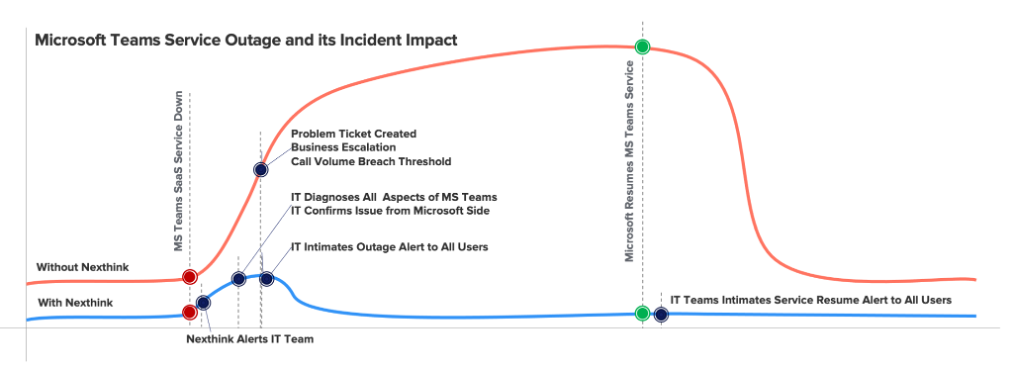While innumerable companies suffered due to the outage, it was business as usual for Nexthink Customers.
On January 25th, 2023, millions of unsuspecting employees across the globe were met with an unexpected roadblock during a regular work day. Microsoft Teams, used by over 280 million users worldwide for video meetings, messaging, and collaboration, was officially declared down.
This unforeseen event impacted a multitude of users, with thousands of reports raised across Asia, Europe, and North America.
Complaints came flooding in, social media blew up (as expected), and many businesses bore the brunt of this unwelcome phenomenon.
- Employees started to troubleshoot the issue themselves.
- Millions of meetings were dropped.
- Countless service tickets were raised in a matter of minutes.
- Business productivity dipped.
- Users everywhere began to get frustrated that their bustling work day had ground to a halt.
It even caused the hashtag #MicrosoftTeams to start trending on Twitter, with users expressing feelings of confusion, exasperation, and disappointment at the widespread inconvenience.
The entire incident took a good five hours to resolve.
But…
We know that at least one company was an exception to all this chaos – zero reports or IT tickets, practically no negative effect on daily work routine, no confusion, and rescheduling meetings.
How?
Simply because they chose to partner with Nexthink.
Within minutes of the Teams app crashing, their IT team was alerted by Nexthink’s Real-time Alerting System about the outage. They jumped into action and averted the potentially disastrous situation. After all, every employee in the company was on the brink of productivity-sapping performance issues, not to mention the gradually increasing number of poor performance calls.

Using the Nexthink Collaboration dashboards, they observed that there were no correlating Wi-Fi or network bandwidth issues. Neither did the problem appear to be related to whether employees were remote or in-office, and they also ruled out the possibility of the issue being region-specific. A quick check of the VPN monitoring dashboard showed no issues on the part of the VPN client. The IT team quickly concluded that it was an outage from Microsoft. And they were able to arrive at this conclusion long before the official outage communication from Microsoft arrived.
Armed with this information, the IT team then proactively reached out to every single employee through a Nexthink Engage campaign, intimated about the MS Teams’ outage, and instructed them to choose alternative communication methods to manage their day’s workload until Microsoft resumed their service.
No meetings fell through the cracks, no delays were suffered during the day’s work, and the outage left zero impact on the business overall.
Thanks to Nexthink’s proactive approach to IT service management, the IT team was able to comfortably monitor in real-time the impact of the outage and its progression within the organization and eventually the recovery phase. Thus the Microsoft Teams outage was detected immediately and all employees were informed instantaneously using Nexthink Engage. All stakeholders were alerted on time and the situation was handled gracefully, even before a single IT ticket or service request could come up.

While innumerable companies suffered, January 25th was business as usual for our client – just another case of proactive IT saving the day.
Don’t let IT outages hamper your business. Handle them the Nexthink way!
According to an IDC survey, downtime could cost Fortune 1000 companies up to a whopping $1 million per hour. The average cost of downtime for midsize and large businesses is around $9,000 per minute and between $127 to $427 per minute for small businesses.
Apply these rates to Microsoft Teams and their millions of users across the globe and you’ve got a number that skyrockets into the stratosphere!